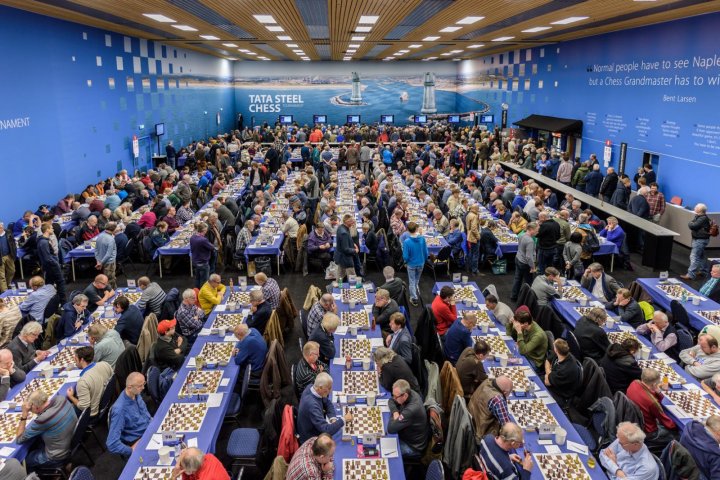The world famous chess tournament series is held every year, usually in January, in the small town Wijk aan Zee, part of the larger Beverwijk, a town and municipality in the province of North Holland in the Netherlands. The seaside location offers the widest sand beach of the country, located next to beautiful dunes.
Initially and longtime, the tournament was called after its sponsor, the Dutch steel producer Hoogovens, 1999 saw the last Hoogovens tournament, the Dutch company merged with British Steel to become Corus. Fortunately for the chess world, the sponsorship continued under the new name Corus tournament from 2000 to 2010. Since 2011, the chess festival is billed as Tata Steel tournament, after Corus had been acquired by Tata Steel, headquartered in India.
From 1938 up to and including 1967, the tournament always took place in Beverwijk, since 1968 it has been held in Wijk aan Zee (pronounced vyke ahn zeh). There was no tournament in 1945.
First winners in 1938 were the Dutch players Philip Bakker and Jilling Van Dijk, in its inception with only four players as an employee tournament for Hoogovens in a pure national event. Max Euwe participated and won a first time in 1940. The tournament became a six players event in 1942, and in 1943, already eight players from the hosting nation took part.
Since 1946, now usually with ten participants, the invitation tournament has been internationally mixed (O’Kelly won ahead of Stoltz that year), in 1960 two players from the Soviet Union did take part for the first time (Larsen and Petrosian tied for the win). From 1964 onwards, there were 16 players competing, in 1963, the field for once even consisted of 18 players, since 1980 it has usually been 14 players strong. Twice, in the years 1993 and 1995, the event changed to a knock-out concours with a marginal back-up Open for the eliminated contenders; in 1994 a ten-player tournament took place.
Since 1996 the Wijk aan Zee tournament usually was a traditional round robin, and usually 14 players were invited. Contrary to most other modern tournaments, Wijk aan Zee always offers an additional B-group, named «Challengers» (there was a C-group during some years, too) for upcoming, rising stars, legendary seniors. And somehow less prominent or overshadowed (grand)masters, plus a bunch of talented chess artists from The Netherlands and, nowadays, India. Of course, women are invited as well, Judit Polgar and Hou Yifan each played five times in the A-group, Nona Gaprindashvili already got a spot in the A-group during the 1970s, and played from the sixties to the eighties several times in the B-group, in 1987 she was shared winner together with Ivan Farago who had the best tie-break, and Luc Winants.
Traditionally, the winner of the B-group advances to the A-group in the following season. 2022 was the year of Arjun Erigaisi, winning Wijk aan Zee-B as a still relatively unknown player, clinching the strong Abu Dhabi Masters and some other Open Festivals, winning the individual silver medal on board three at the Chess Olympiad in Chennai, becoming National Indian Champion a first time, surpassing the notorious 2700 Elo barrier in style, and last but not least, landing a big personal sponsorship deal with Quantbox Research. Virtually everything started with winning the B-group at Wijk in January a year ago.
Not to forget the large amateur events! The Tata Steel tournament welcomes about two thousands of amateur players every year. Wijk aan Zee is definitely a chess festival for both, amateurs and professionals. All rounds are open to the public.
A quote attributed to Bent Larsen captures the significance and tradition of the series: "Normal people have to see Naples before they die…, but a chess grandmaster has to win the Wijk aan Zee tournament first of all".
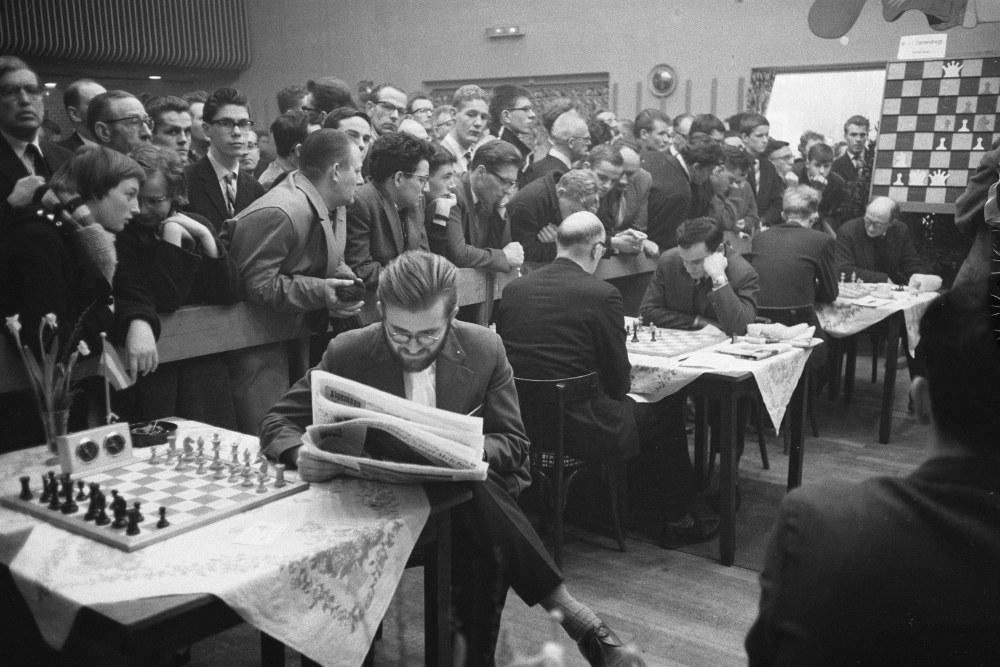
Bent Larsen reads the news while his colleagues play. The picture was taken during the tournament in Beverwijk 1961 which Larsen won together with Borislav Ivkov. | Photo: Harry Pot, Anefo
Record winner
Record winner with eight titles (so far) at the Hoogovens / Corus / Tata Steel invitation tournament held in Wijk aan Zee and in earlier years in Beverwijk in its long history, is Magnus Carlsen.
In 2004 a 13-year old Magnus Carlsen won the "C" group in Wijk, making his first GM norm on the way. In 2006, he was first (alongside with Alexander Motylev) in the "B" group.
In 2008 (together with Levon Aronian), 2010, 2013, 2015, 2016, 2018, 2019, and 2022 (always clear first), Carlsen won the "A" group. Magnus Carlsen is a regular visitor in Wijk aan Zee and will play for the 19th time overall in 2023, making his 16th A-entry.
Vishy Anand won or co-won five times (among them three shared titles), four players won four times each (sole or / and shared) at Beverwijk and Wijk aan Zee respectively, namely Max Euwe, Lajos Portisch, Viktor Korchnoi, and Levon Aronian who is playing again this year.
This DVD allows you to learn from the example of one of the best players in the history of chess and from the explanations of the authors how to successfully organise your games strategically, and how to keep your opponent permanently under pressure.
Longest winning span at Beverwijk / Wijk aan Zee series

Ping-Pong with the suit coat still buttoned. That’s serious old school. Chess Grandmaster Korchnoi at the Wijk aan Zee Hoogovens tournament, January 1968. | Photo: J. de Nijs, Anefo
The longest winning span at Wijk aan Zee / former Beverwijk series is held by Viktor Korchnoi with 19 years (tournament victories between 1968 at his first participation and 1987, in total four wins), ahead of Max Euwe, 18 years (between 1940 and 1958, four wins), followed by Fridrik Olafsson, 17 years (between 1959 and 1976, two wins), and Viswanathan Anand, also 17 years (between 1989 and 2006, five wins).
Biggest winning margin at Beverwijk / Wijk aan Zee
The record winning margin in absolute points at Beverwijk / Wijk aan Zee A-tournament series since its beginning in the year 1938 is also held by Viktor Korchnoi. In January 1968 (it was the first Hoogovens played at Wijk aan Zee), Korchnoi finished winning the tournament with 12 out of 15, three full points ahead of shared runners-up Lajos Portisch, Mikhail Tal and Vlastimil Hort.
In this video course, experts (Pelletier, Marin, Müller and Reeh) examine the games of Viktor Korchnoi. Let them show you which openings Korchnoi chose to play, where his strength in middlegames were, or how he outplayed his opponents in the endgame.
At his first entry at Hoogovens tournament in 1968, Korchnoi started with a streak of eight consecutive wins (!), beating in a row GM Padevsky (rd.1), GM Matanovic (rd.2), GM Bobotsov (rd.3), GM Ivkov (rd.4), IM (GM later) Hans Ree (rd.5), IM Nikola Karaklajic (Serbia, Yugoslavia), who was selected from the Masters section at Beverwijk Hoogovens - B in 1967 (rd.6), GM Rossolimo (rd.7), and GM Tal (rd.8), then drawing to GM Donner in round nine.
Note: At the end of that year, in December 1968, Korchnoi took the world elite tournament of Palma de Mallorca, too, featuring the World Champion Petrosian, his upcoming Challenger and Vice World Champion Spassky, and Larsen, the Palma winner from 1967. Korchnoi, clear first and unbeaten, made another fine tournament, as he drew Petrosian and defeated Spassky, Larsen and Gligoric, amongst others. Thus, in the final round he easily could grant half a point to a Spanish player. According to Chessmetrics, these were the two strongest tournaments of 1968, in historical ranking, Korchnoi then was second behind Bobby Fischer during 1968 (all twelve months) and 1969 (all twelve months).
Korchnoi presents many of his most brilliant efforts from the years 1949-2005, among them, games against Smyslov, Geller, Tal, Huebner, Karpov, Kasparov, Spassky and Short.
Oldest winner
Savielly Tartakower (1887-1956), is the oldest winner of the series at age of near 62 years (!), taking clear first place in 1949 at Beverwijk (facing much less strong opponents in a smaller event than usuall today). Euwe, Botvinnik, and Korchnoi all won at Beverwijk and Wijk aan Zee, in their mid-/late 50s.
Youngest winner
Magnus Carlsen (*1990), co-winner with Aronian in 2008 (incl. Anand, Kramnik, Topalov, the then top three of the world ranking, Mamedyarov, Leko, Ivanchuk, Gelfand, Radjabov, Adams) at age of 17 years and two months.
Best woman ever
Judit Polgar as best woman ever at Beverwijk / Wijk aan Zee was clear runner-up in 2003, only half a point and unbeaten behind the winner. And here are the full standings from the tournament, which was played exactly twenty years ago (some players are still active, but none of them are participating in the 2023 A or B edition):
1. Anand, 8.5 points
2. Judit Polgar, 8
3. Bareev (title defender from Wijk aan Zee tournament 2002), 7.5
4.-8. Shirov, van Wely, Grischuk, Kramnik (reigning Einstein world champion), Ivanchuk, 7
9.-10. Radjabov, Topalov, 6.5
11.-12. Karpov (former world champion), Ponomariov (reigning FIDE world champion), 6
13. Krasenkow, 4
14. Timman, 2.5
Polgar’s result is also regarded as one of the best ever achieved by a woman in classical chess.
The strongest tournament of the series
The strongest event of the series happened arguably in 2001, when nine top ten players participated, namely #1 Kasparov, #2 Anand, #3 Kramnik, #4 Adams, #5 Leko, #6 Morozevich, #7 Shirov, #8 Topalov, #9 Ivanchuk from the official FIDE Elo rating list in January 2001 (only missing out from the top ten is the number ten ranked Gelfand). Kasparov won unbeaten a third time consecutively, three entries, and three clear wins, always surpassing strongest opposition.
That means, the claim "Strongest ever field" for 2023 (Strongest field ever' at 85th edition of the Tata Steel Chess Tournament) is doubtful, several editions with more top ten / top twenty ranked players had been organised before.
Kasparov’s trilogy
Garry Kasparov played and won the tournament in Wijk aan Zee three times in a row, namely in 1999, 2000, and 2001.
It was at Wijk in 1999, when Garry Kasparov created his masterpiece against Veselin Topalov:
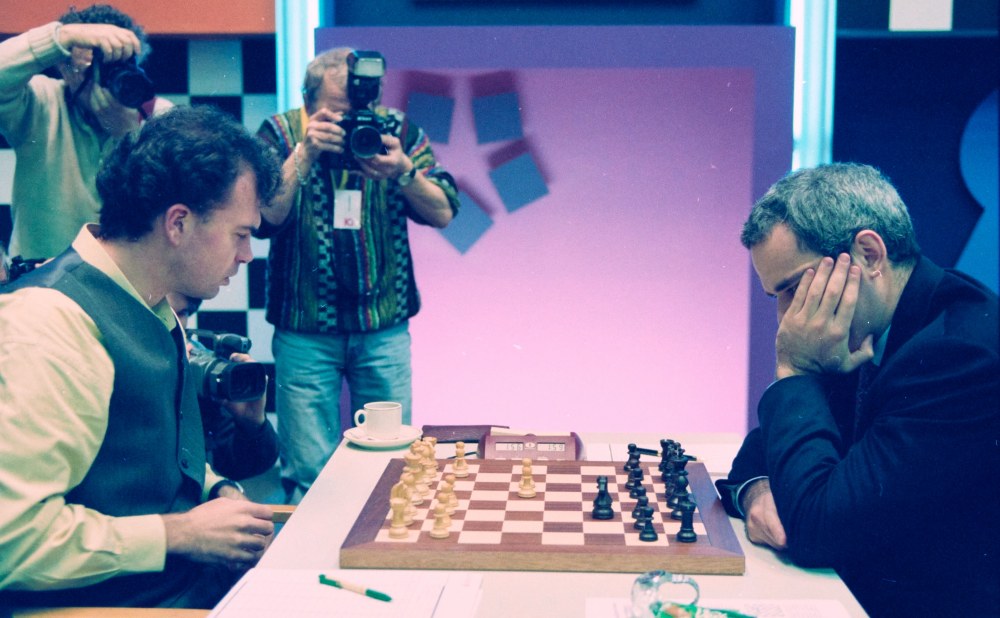
Ivan Sokolov beat the "Beast from Baku" at Wijk aan Zee in 1999. | Photo: noord-hollandsarchief.nl
In total, Garry scored +19=19-1 at Wijk aan Zee (always 14 players / 13 rounds single round robin). His only loss:
In an interview with Sagar Shah, Ivan Sokolov remembered this famous win against Kasparov:
Question: When you saw that Kh7 was a mistake and that you could win the game now, what went through your mind?
It was kind of a funny moment because we both had plenty of time on the clock. I realized that after I triple on the g-file it was going to be mate.
Kasparov was already prepared to resign and leave. He had his Rolex back on his hand, his chocolate was taken away from the board, his jacket was on. Basically he was saying - Come on, make this move and get it over with!
Then I said to myself - Hang on, when is the next time that I will have such a position against Kasparov from which I can demolish him in just one move? Perhaps never!
How much time did I have on my clock? 40 minutes! Well, let's wait for a while then! Have a look at this beautiful position, look at miserable him (Garry really looks miserable when he is lost), there is no reason to rush!
So I took 10 minutes and then executed the move and he immediately resigned. *Smiles*
For the full talk (keep in mind, this interview is from 2015), see:
Interview with Ivan Sokolov (1/2) | ChessBase and
Interview with Ivan Sokolov (2/2) | ChessBase
Following his playing career, grandmaster Ivan Sokolov has become a renowned chess trainer, most recently leading the Uzbek national team as their coach to victory at the Chennai Olympiad in 2022.
The last non-titled tournament winner at Beverwijk / Wijk aan Zee

Mission accomplished. The winners of Beverwijk 1964, Nei (on the phone) and Keres, 26 January. | Photo: Eric Koch, Anefo
The titleless Iivo Nei, together with GM Paul Keres, both from Estonia, won at the prestigious Beverwijk Hoogovens tournament in 1964 (with many elite players, GM Portisch was sole third, GM Ivkov sole fourth, GM Larsen joint fifth, including GM Parma, GM Filip, GM Donner or GM Bobotsov).
At that time, there was no official FIDE Elo list existing. Nei got the IM title for this big tournament triumph, but he never was awarded the GM title (nor the GM Honorary title later). In retrospect, from 1960 to 1976 Nei was a top-100 player according to the Chessmetrics historical ratings by Jeff Sonas. Nei was best-ranked on position 21, and has beaten many greats. Iivo Nei, born in 1931, is still alive, and it would be a nice gesture to grant the grandmaster title to him.
Preferred Partners
Dutchman Loek van Wely played incredible 25 times in 26 years (from 1992 to 2017, except in 2000) in the A-group at Wijk aan Zee, but could never win and never made it to the podium! Loek's best result is a shared 4th-8th place in 2003. Five times, he finished as shared or sole last.
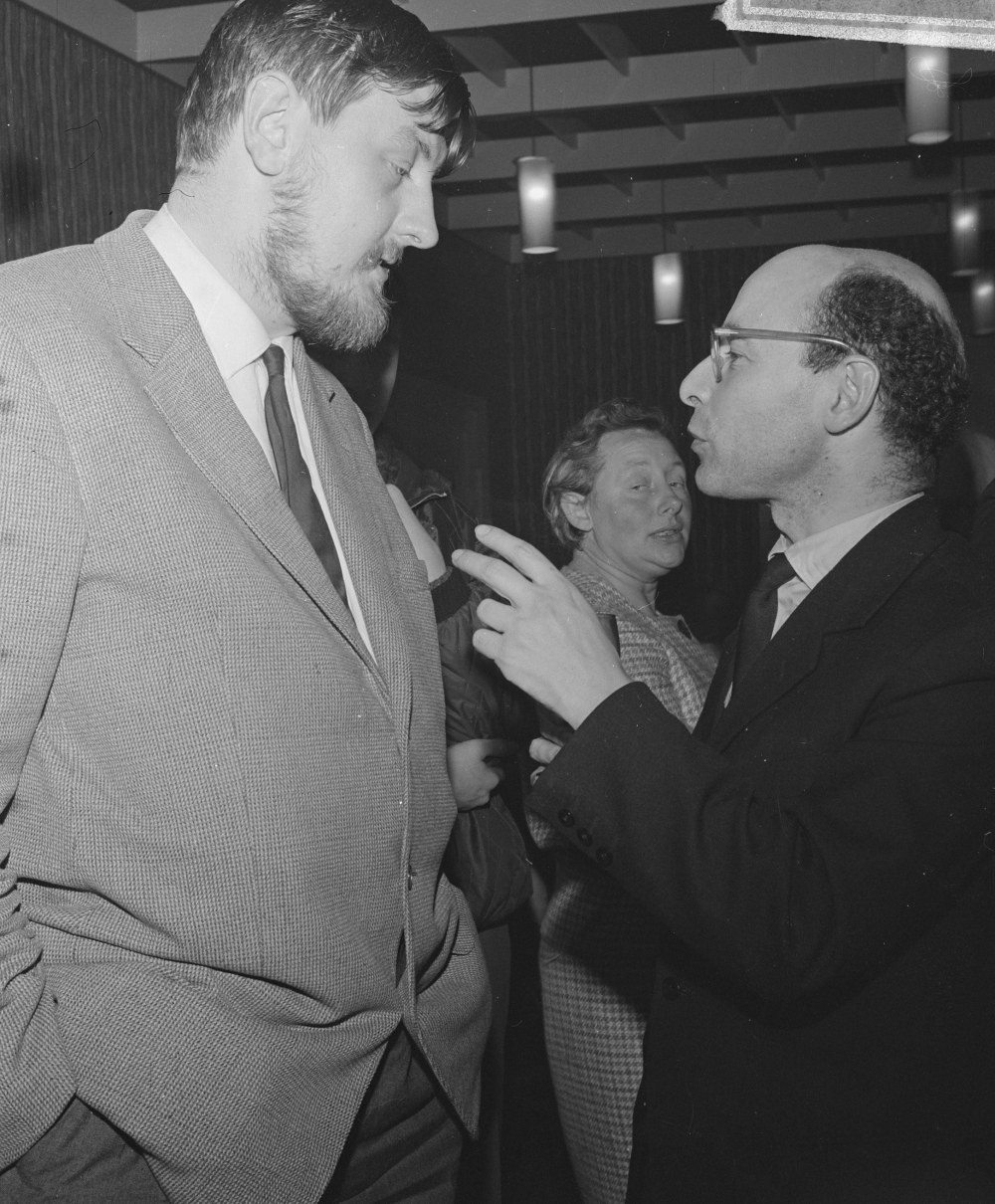
Hoogovens Beverwijk 1963. The big winner Donner and clear runner-up David Bronstein have a chat. | Photo: Eric Koch, Anefo
Jan Hein Donner played 24 Beverwijk / Wijk aan Zee – A groups (from 1950 to 1975, except in 1954 and 1956), he won three times, in 1950 outright (ahead of 2./3. Euwe, Rossolimo), in 1958 shared with Euwe, and in 1963 outright (ahead of 2. Bronstein, incl. Averbakh, Pilnik, Matanovic, Ivkov, O’Kelly, Parma, veteran Pirc, Stahlberg, 18 players, arguably Donner’s biggest international win), ten times he finished in the bottom half of the usually strong tournament table.
PS: Prins, 1 win, in total only got 3 entries. Donner and Prins were not on friendly terms
Theo Van Scheltinga made 21 appearances at Beverwijk and later Wijk aan Zee between 1944 and 1969, winning twice in the 1940s (the early years of the series weren’t that strong)
Chess legend Jan Timman took part exactly 20 times between 1972 and 2004, not counting further B-sections and a honorary tournament, he triumphed twice, but also finished four times sole last in the A-group
Further frequent players from the hosting nation (selection)
Ree 19x – best result as fourth/fifth
Langeweg 16x – sole sixth out of 16 players in 1966
Piket 15x – he came close in 1997 as shared second after a loss in the last round, Salov won
Van der Wiel 15x – two podium finishes as shared second and shared third
Giri 12x in a row at Wijk aan Zee – A, and also playing in 2023, he twice tied for first place, in 2018 and in 2021, but losing both times the speed tie-break (2018 was the first year, where Wijk aan Zee established a play-off, otherwise Giri would be a twice tournament winner, comparisons with earlier years may be biased, thus)
Cortlever 12x – one win in 1939 in a pure national Quadrangular
Sosonko 12x – two wins, joint with Geller and joint with Timman
Tiviakov 7x – clear runner-up in 1994 (no player from the top ten), Nikolic won
(Other) elite players at Wijk aan Zee / Beverwijk
Anand 19x (5 wins)
Carlsen 15x in A-group (record winner with 8 A-wins), Carlsen played 18x in Wijk A, B, C group, starting in 2004, this year will be his 19th visit overall, and his 16th A-group attendance since 2007, he only left out the edition of 2014
Adams 14x (none, shared second as best result)
Korchnoi 13x (4 wins), Kramnik 13x (1 win, at his first entry in 1998, together with Anand)
Leko 12x (1 win), O’Kelly de Galway 12x (1 win), I. Sokolov 12x (none, shared second), Topalov 11x (2 wins), Nikolic 11x (2 wins), Karjakin 11x (1 win), Andersson 11x (1 win)
Aronian 10x (4 wins, playing in 2023), Caruana 10x (1 win, playing in 2023), Ivanchuk 10x (1 win), Hort 10x (none, but four times (co-)runner-up), Shirov 10x (none, shared third), Portisch 9x (4 wins), Gelfand 9x (1 win), Ivkov 9x (1 win), Hübner 9x (none, shared third), Short 8x (2 wins)
Euwe 7x (4 wins), Nunn 7x (3 wins), F. Olafsson 7x (2 wins), Browne 7x (2 wins), Matanovic 7x (1 win), Radjabov 7x (1 win), Miles 7x (none, shared second), Kavalek 7x (none, no podium), So 6x (1 win, playing in 2023), Seirawan 6x (1 win), Ljubojevic 6x (1 win), Pilnik 6x (1 win)
Mamedyarov 5x (none, shared second), Larsen 5x (2 wins), Salov 5x (2 wins), Tal 5x (1 win, remember, the great attacker Tal, who died in 1992, never got a nomination / invitation at the Linares tournament), Rossolimo 5x (1 win), Nakamura 5x (1 win), Judit Polgar 5x (none, sole runner-up), Bobotsov 5x (none, sole third), Morozevich 5x (none, shared third), Svidler 5x (none, no podium), Hou Yifan 5x (none, no podium)
Some selected top players with less than five entries in the series
Geller 4x (3 wins, all were shared), Karpov 4x (2 wins), Stahlberg 4x (1 win), Bareev 4x (1 win), Grischuk 4x (none, sole runner-up), Nepomniachtchi 4x (none, shared third), Rapport 4x (none, shared second, playing in 2023), Ponomariov 4x (none, no podium), Duda 4x in a row 2019-2022, and again invited in 2023, had to withdraw (none, no podium)
Kasparov 3x (3 clear wins in a row!), Ribli 3x (1 win), Sax 3x (1 win), Dreev 3x (1 win), Ding Liren 3x (none, twice shared second, playing in 2023), Szabo 3x (none, sole second), Gligoric 3x (none, shared second), Pomar Salamanca 3x (shared second), Vachier-Lagrave 3x (none, shared second), Smejkal 3x (sole third), Adorjan 3x (none, no podium), Lautier 3x (none, no podium), Benko 3x (none, no podium), Kamsky 3x (none, no podium), Wojtaszek 3x (none, no podium), Eljanov 3x (none, no podium), Navara 3x (none, no podium)
Polugaevsky 2x (2 wins, both as clear first), Petrosian 2x (1 win), Taimanov 2x (1 win), Keres 2x (1 win), Nei 2x (1win, titleless!), Beliavsky 2x (1 win), Mecking 2x (none, no podium), Torre 2x (none, no podium)
One participation (selection in no particular order): Tartakower (1 win), Botvinnik (1 win), Spassky (1 win), Eliskases (sole runner-up), Bronstein (sole runner-up), Uhlmann (sole third), Yanovsky (shared third), Smyslov (shared fifth in 1972, Portisch won above 2./3. Pomar, Hort, 4. Browne, 5.-6. Savon, Smyslov), Flohr, Averbakh, Vaganian, R. Byrne, Pachman, Unzicker, Panno, Speelman, Bacrot, Kmoch, Kostic, Grünfeld, and unforgotten Vugar Gashimov in 2012 in what sadly turned out to be his last tournament in classical chess before his death in January 2014.
Eleven undisputed, universally accepted World Chess Champions played the series, all since Euwe, except Fischer. There are only a few other prominent players since end of World War II, who never took part / couldn’t play at Beverwijk / Wijk aan Zee, ie. Reshevsky, Boleslavsky, Kholmov, Kotov, or Stein.
PS: Wijk aan Zee also hosted some official FIDE Candidate’s matches, for instance in 1991, with Jussupow beating Dolmatov, and Korchnoi (60 years) beating Sax. For reasons of consistency, such events are not included in the stats and figures above; in the official website, they are listed, too.
Youth Mania in recent years
The Tata Steel invitation tournament in January 2021 had an exceptional young line-up: All of the participants were below 40 years, it’s insane, none of the 14 chess players had yet celebrated his 35th birthday! The oldest player from the January 2021 field, Harikrishna, is born in May 1986, and the youngest player, Firouzja, born in 2003, is aged 17 and a half.
Such an average of age is notable and likely to be a novum in the long and great history of the Wijk aan Zee series: the age average of the players is around 26-27 years, roughly calculated.
Same went for the edition in 2022: The oldest participant is near 37, the youngest player is 16 and a half. Age average of the players is again around 26-27 years, roughly calculated.
In 2023, surprisingly, reigning World Champion Carlsen (born in November 1990) with 32 years of age is already the second-oldest player in the field of the nominated 14 A-participants, only Aronian, who was born in the 1980s, is older than Magnus.
Times are changing
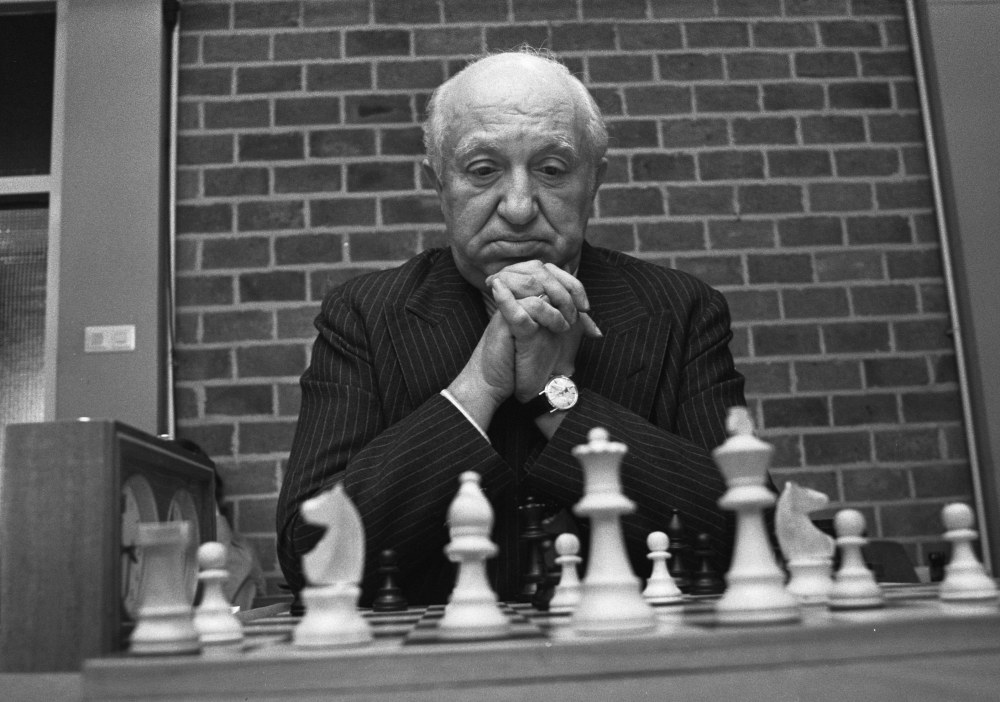
An iconic picture of Miguel Najdorf in play at Wijk aan Zee, 24 January 1973. | Photo: Bert Verhoeff, Anefo
Miguel Najdorf (born in April 1910, died in 1997), gave his debut at Wijk aan Zee tournament in 1971 (Korchnoi won in his second and last entry at Wijk aan Zee as a Soviet player, above 2.-5. Ivkov, Gligoric, F. Olafsson, Petrosian, followed by 6.-9. Andersson, Hort, Hübner, and Mecking, alphabetical order, 16 players) when he had already celebrated his 60th birthday!
Kostic played in 1952 in Beverwijk (Euwe won above O’Kelly, Yanofsky and Rellstab joint third) at age of 65.
After a long break from tournament chess Grünfeld, who was 67 at that time, played in 1961 in Beverwijk (Larsen and Ivkov won two full points ahead of Uhlmann). He died a year later.
Najdorf played at the Hoogovens (since 1968 held in Wijk aan Zee) a third and last time in 1978 (Portisch won half a point above Korchnoi, Andersson third) at the age of 68.
Korchnoi played in 2000 (Kasparov won 1.5 points ahead of joint 2.-4. Anand, Kramnik, Leko, including further top players such as Morozevich, Adams, Short, Nikolic, Timman, Piket, or Judit Polgar who tied with Korchnoi) at the age of 69.
The veteran players could avoid to be last or co-last as it happened in the A-group to a young Carlsen, and Kramnik, Shirov, Gelfand, Morozevich, Ljubojevic, Adams, Navara, young Rapport, young Giri, Timman, Donner, or Van Wely who indeed all finished last or co-last at least once in the main section of the series!
Najdorf and especially Korchnoi who won a year later at Biel GMT in 2001 above Svidler, Gelfand, Grischuk, and Lautier, were still busy on the circuit and competitive on highest level.
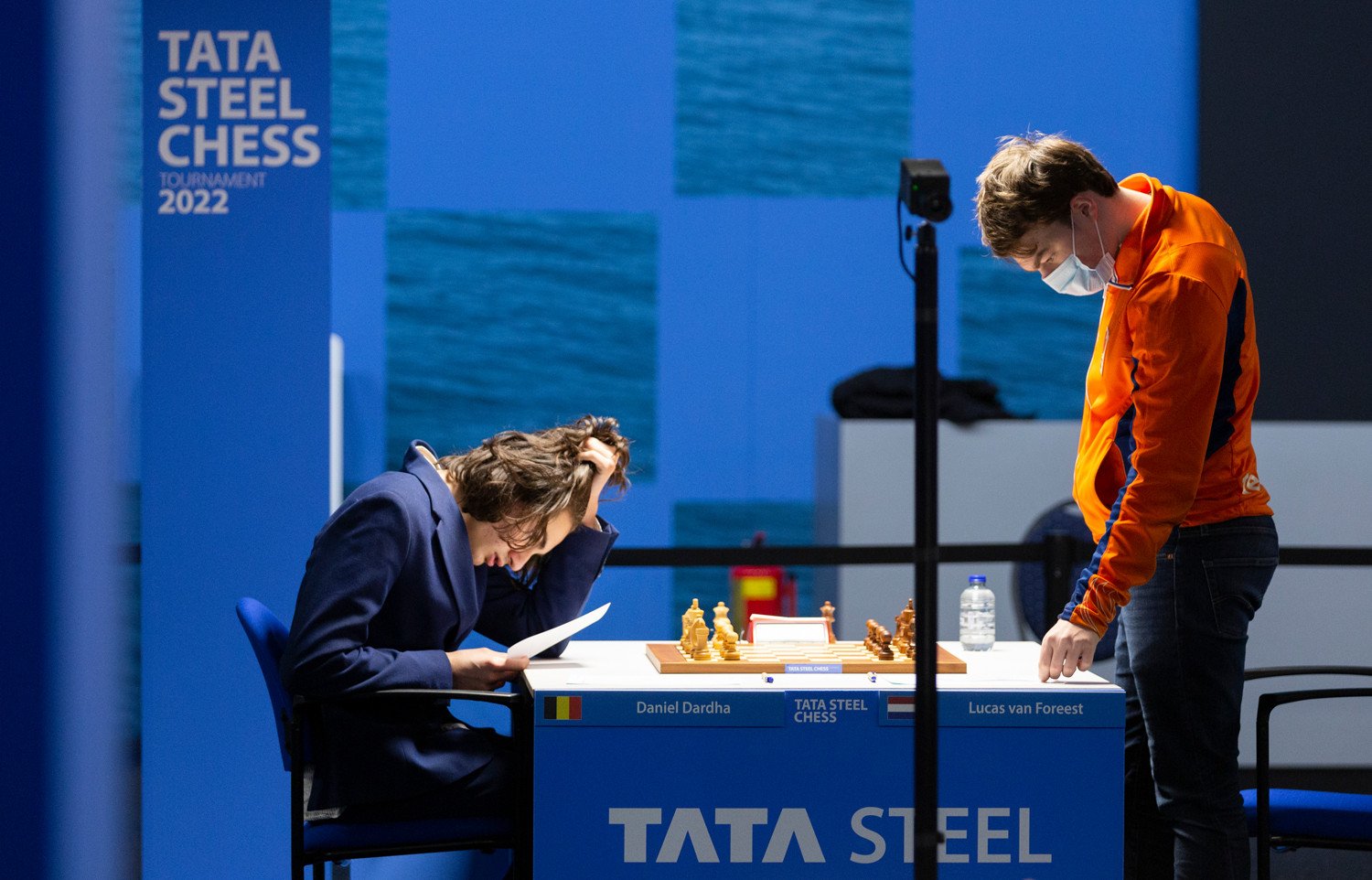
Did I miss to pay my taxes? Err, the new anti-cheating rules, and special play-off regulations, plus pandemic prevention measures, …not to forget, FIDE reforms qualifications paths to Candidates Tournament, life is getting complicated! Belgian prodigy Daniel Dardha and Lucas van Foreest (with mask) at Wijk aan Zee - B group, 29 January 2022. | Photo: Jurriaan Hoefsmit, Organiser
An entertaining and exciting 85th Wijk aan Zee Tata Steel Tournament to all chess lovers!
Statistical rhubarb is subject to change. Some data are taken from the site www.chessdiagonals.ch, maintained by the author.
Official Website: Tata Steel Chess Tournament 2023
